BIOS -
BIOS is an acronym that stands for Basic Input/Output System. It is meant to control your product at a very low level. As of right now there are three regularly used BIOS formats (there are actually more than that but there are three common ones). These are the AMI (American Megatrends Incorporated), Award, and Phoenix. Asus was one of the first companies (outside of Intel) to fully embrace the UEFI BIOS standard. They have been working to develop this format and give it as much functionality as they can. One of the items that we especially like is the ability to take direct screen shots right from the BIOS. All you need to do this is a FAT32 formatted USB thumb drive and you are good. It is great for keeping information about changes and also works out great for us. 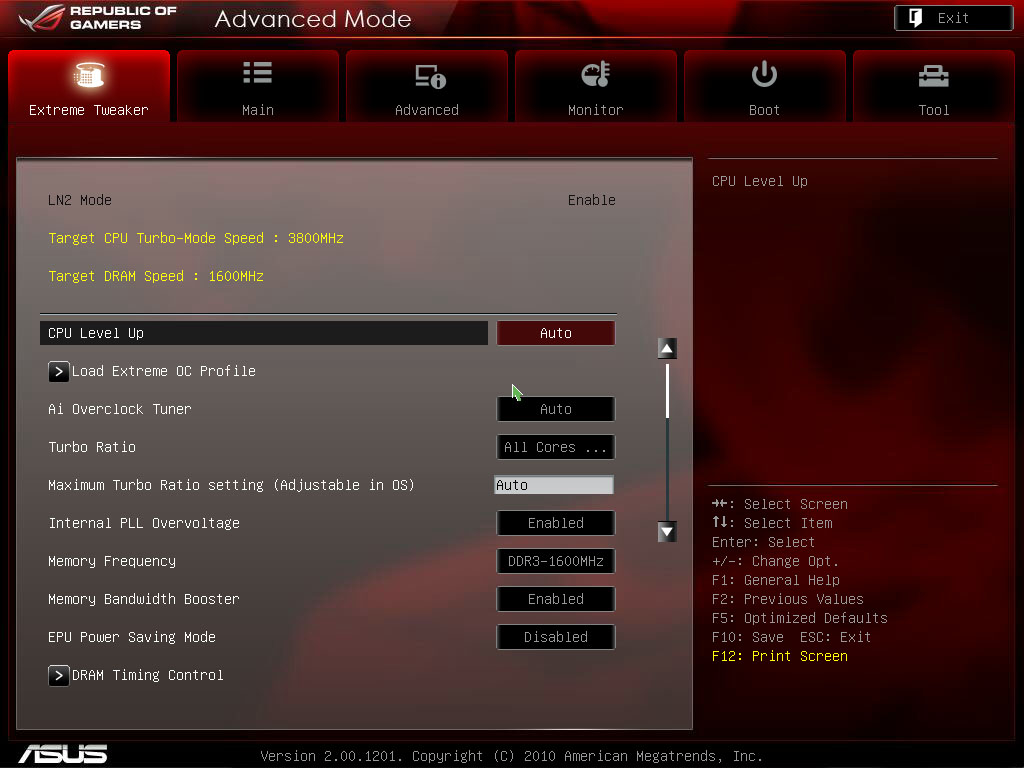
The UEFI BIOS on the Maximus starts you off in advanced mode by default. There is no mucking around with the EZMode, but then again this is a board that is meant to be tweaked. You start off on the Extreme Tweaker pages which are very similar to what Asus offered in their traditional BIOS, but with more input options and flexibility.
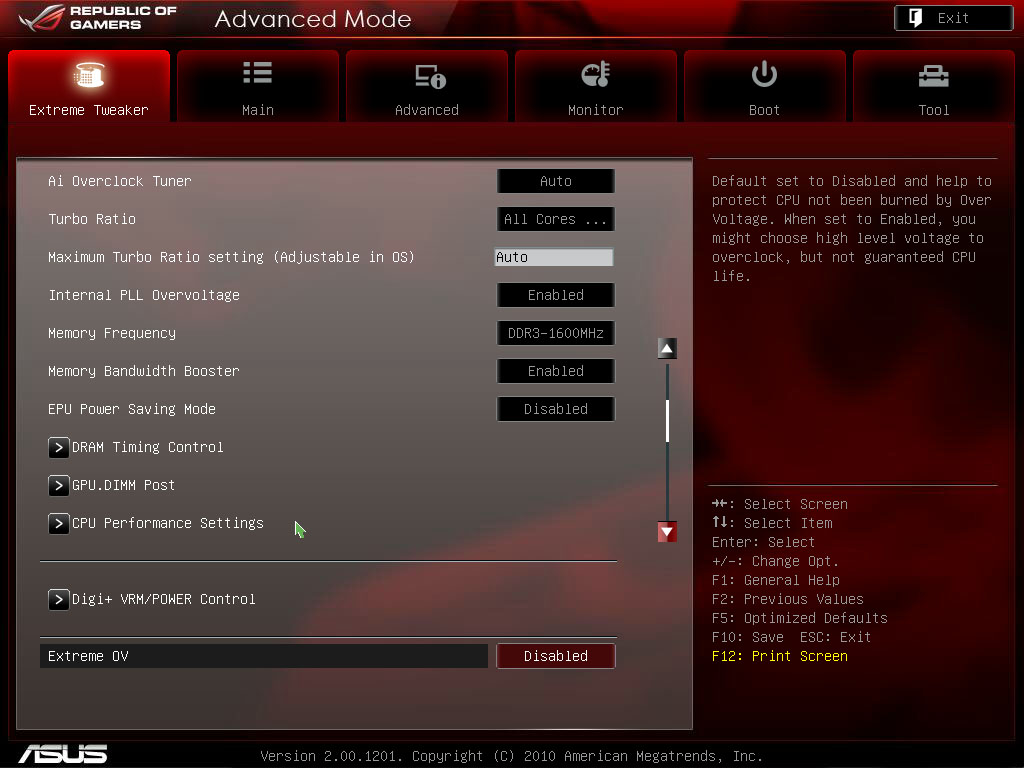 |
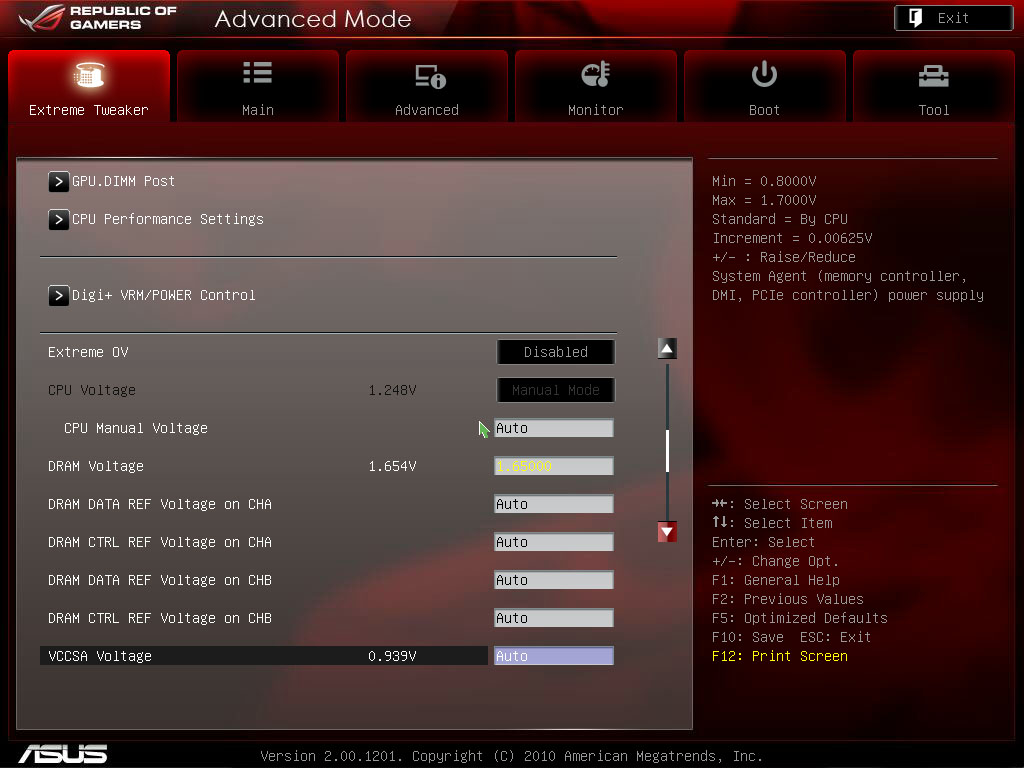 |
One thing to talk about (although we have covered it before) is the Digi+ VRM. The Dgig+ VRM on the Maximus IV Extreme (Ok, moving forward we will call it the MIVE) is the 6th generation of Asus’ power controls for their motherboards. They were right after DFI when it came to the flexibility of power controls, but while DFI could not continue to innovate, Asus was able to push forward and has built on their platform to allow even greater control. With the launch of the P67 chipset they started pushing the Digi+ VRM into their mainstream products. We will cover what you can do with Digi+ a little more in-depth when we talk about AI Suite II.
The rest of the Extreme Tweaker Section will look very familiar and has the controls you need/want to get the most out of your CPU. As for the rest of the BIOS, the UEFI makes it much easier to maneuver around (as you can use the mouse), but Asus has not left out things like direct input. You can still key in the numbers you want to get things going quickly. You also do not get the lag or incorrect mouse translation like you have on other UEFI BIOSes. With the Asus version the mouse movement is smooth and the layout is very clean. We have a gallery of the BIOS on the MIVE below.
{gallery}Reviews/01-23-2012/Maximus_IV_Extreme/Part_II/bios{/gallery}
Overclocking -
I have one thing to say about the overclocking on the MIVE; Wow. We have been trying to get to 5GHz stable on a number of motherboards and despite multiple tweaks and tries we have always had to drop back to 4.9GHz. This was not the case on the MIVE. We went straight to 5GHz and everything just worked. We are more than confident that with some extra work we can get this board to hum along nicely at 5.2 or even higher as of this writing we have all but Lightwave 3D running smoothly at 5.2GHz so we know that this is well within reach.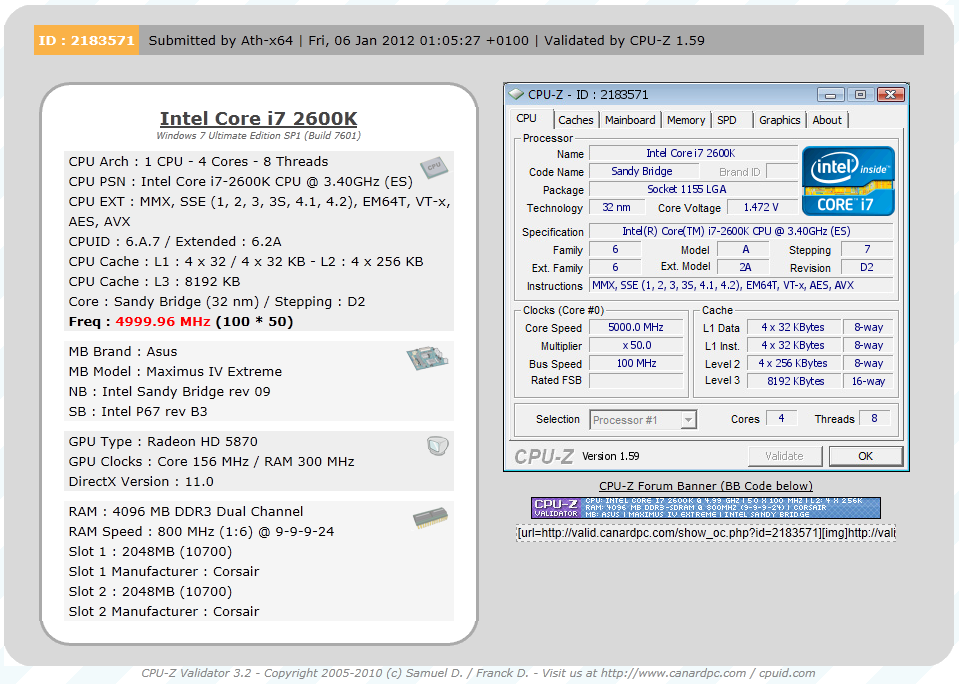
Of course overclocking is a picky subject. I can buy to identical CPUs from the store and they will not always perform the same way under stress. This is the same with motherboards, RAM and GPUs. So again it is important to keep in mind that our results represent a specific hardware configuration. Yours may be similar but will rarely be identical.
Overclocking Tools -
Asus’ overclocking tool is called AIsuite II (like you did not know that). It is probably one of the best Windows based tools available. This is not just in functionality, but also in ease of use and the look of the software. 
The version on the MIVE is a little different than what we are used to on the Extreme products from Asus. Normally the auto-tuning function is not available (they figure you are going to want to tweak it on your own). On the MIVE that tool was present, but it was not all that great for getting a nice high clock speed. Our run with the Auto Tuner (using the extreme profile) only got us to 4.5GHz, this is a speed that is we have easily hit before so we were actually surprised to see it stop there.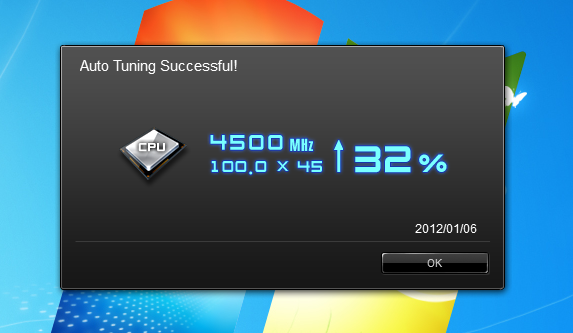
The rest of the AISuite II is very functional and designed with the overclocker in mind. There is even an entire page devoted to the Digi+ VRM. Here you have great options for adjusting the Phase Control, Load-Line Calibration, Current Protection, and even the Switching Frequency mode. Each of these plays a very important role in overclocking.
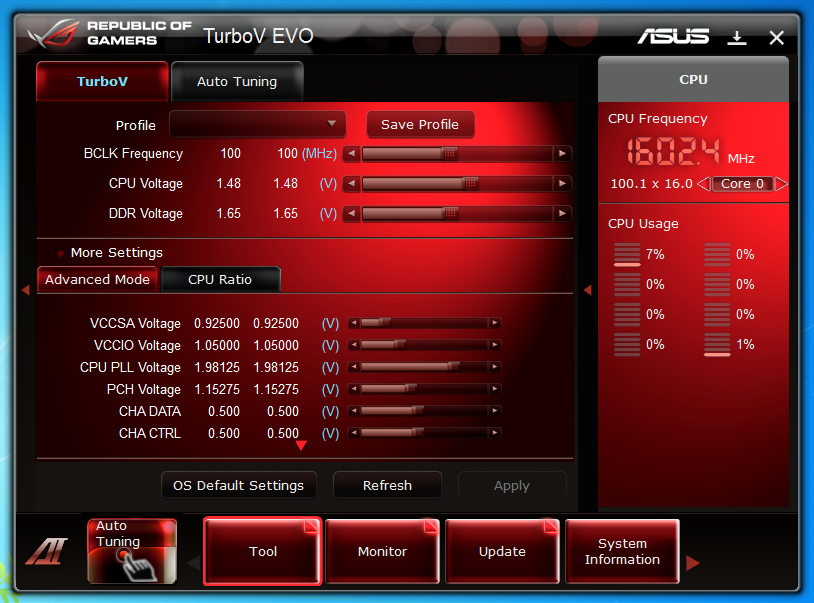 |
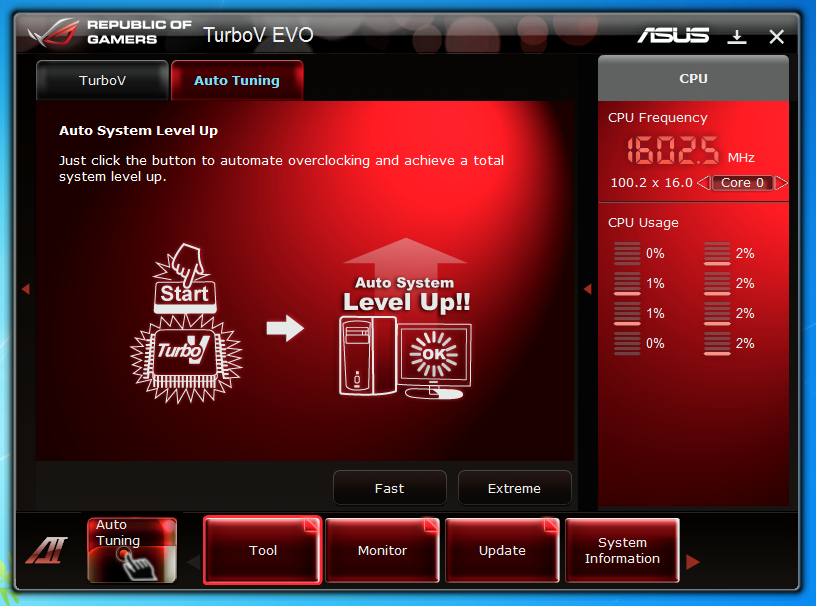 |
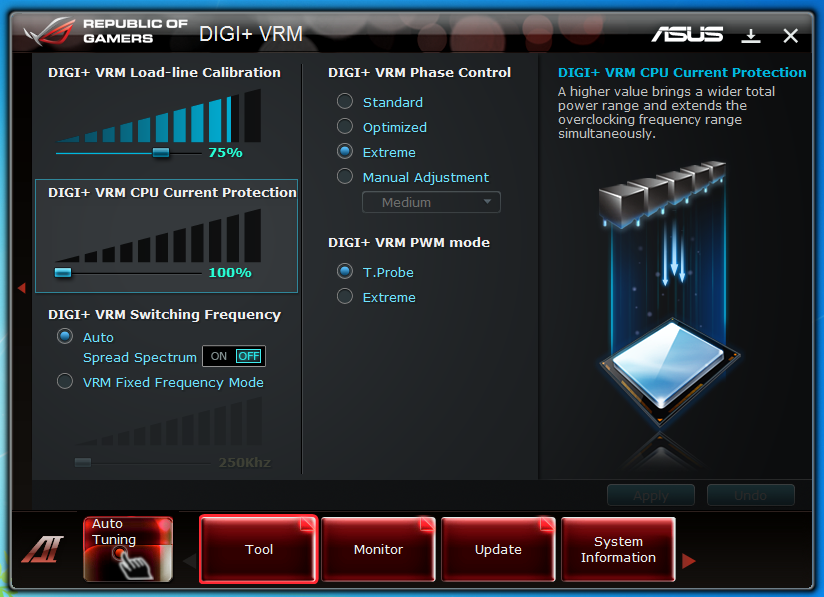 |
Current Protection allows you to extend the amount of voltage available to the CPU so that you can push it higher (this will be even more important in the 3xxx Seires Core i7s).
Load-Line Calibration helps to prevent voltage droop when overclocking and provides more stability to your memory subsystem.
Phase Control and Switching Frequency are design to help overcome crosstalk and signal bleed at high frequencies and when you are pushing a lot of power through your system.
The design is very visual and lets you quickly adjust each of these to get the best result.
 |
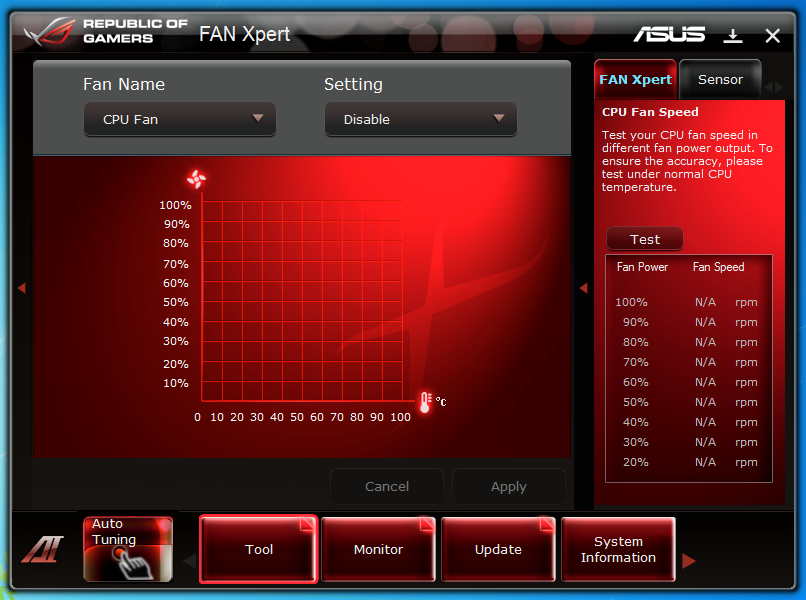 |
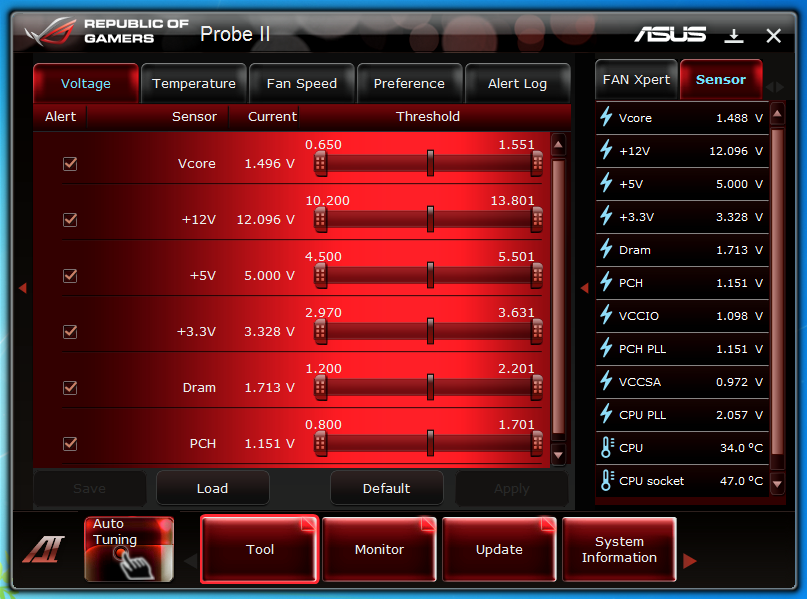 |
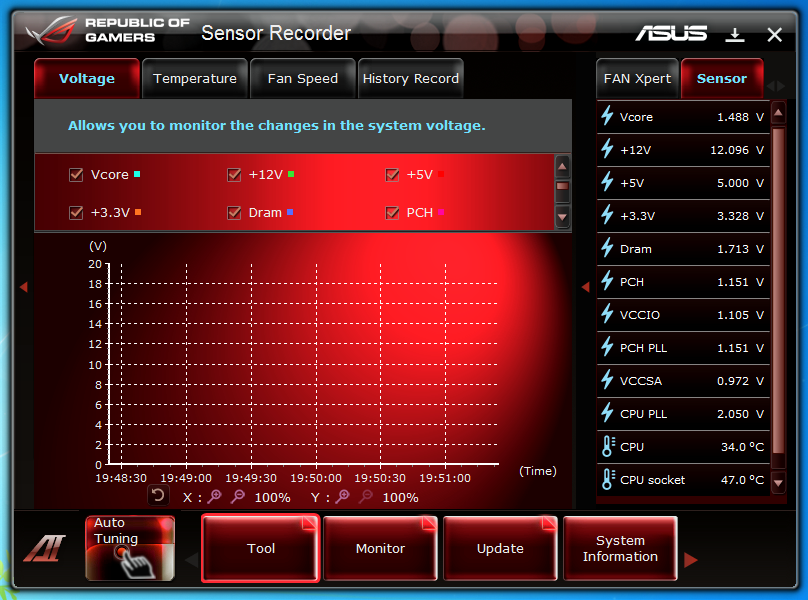
Asus has also included their EPU software on the MIVE which it handy if you are choosing to run this at stock speeds. If will help you get the most power efficiency out of your board. On the other hand if you are overclocking, well it will only run in high performance mode. Asus did not leave out tools to monitor and control the fan headers on the MIVE. You have complete Fan Xpert controls along with an improved Probe II software suite to keep track of all of your voltages, temperatures and even the fan speeds on your system.
 |
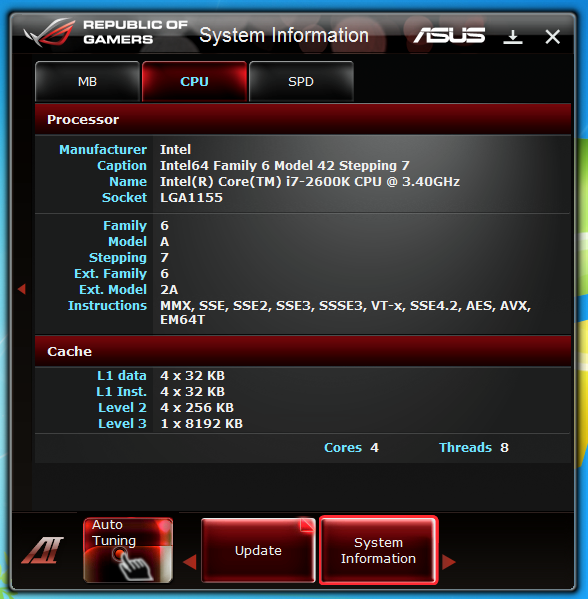 |
The Update and System information pages are self-explanatory so we will just leave you with the screen shots.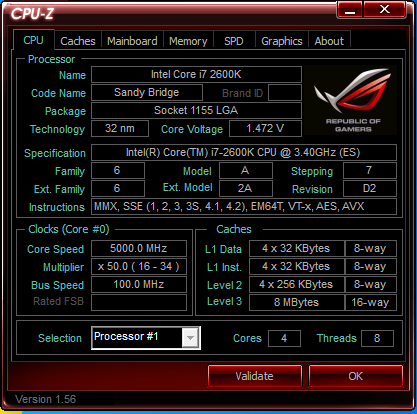
A new feature on the ROG boards is an Asus branded version of CPUz. Unfortunately the one here was out of date so we could not use it to upload our overclock with it. We had to grab a current version and then push it up. Still it does look cool and is nice for screen shots.
ROG Connect -
This suite of applications lets you overclock your system remotely via USB or through the BT Connect software. Although both are very cool and fun to play with we found them somehwat gimicky for most users and was not soemthing that we could see someone using consistently. Still as we said both of these utilities are fun to play with.
The Test System and Comments -
Our test system is built on an open bench. This has two effects on testing. First it allows us to see everything and also to setup and disassemble the test rigs quickly. Second it means that we cannot gauge the potential air flow found in a normal case. The air is pretty stagnant; some may say this is a great neutral testing method and it can be. However, it does mean that the temperature reading taken off of the components are not accurate to what an average consumer would see. This means that your thermal performance will vary from what we see here.
The MIVE is a nice board. It has a great layout and is very easy to work with. The UEFI BIOS makes getting around and finding the settings you need simple and quick. Meanwhile, on the software side, Asus has you covered with their InstALL. The only thing that I do not like about this is that they add in some basic shovelware like Norton and a webconfig application that does nothing but give you the option to install some web games. Still at least you can uncheck these and prevent their installation.
Once you have your OS of choice and all of your drivers installed, you can use Asus’ tools to get the most out of your MIVE. The end user experience is quite nice.
Performance testing overview -
Our testing is a little different than most. We combine both synthetic and real-world applications to simulate the types of performance common to the individual products. For motherboards this means that we run roughly six synthetic tests and two real-world. We will be expanding the real-world testing in the near future. But there is more to performance than just the raw numbers. As there are multiple components and sub-components on a motherboard there each item can have a distinct impact on the way the product will perform once you get it in your system. It is important to note not only the actual results but what they mean to you as a potential consumer. We will try to give this information to you.
But we do not just cover the performance aspects that are measurable. We also talk about the components that might not have a direct benchmark. These are items like Audio Quality, ease of use and installation.
Section 1 Subsystems -
Memory -
Memory performance is very important on a motherboard, especially when you have a CPU with multiple cores and threads. If you have slow memory your cores and threads can become starved for data to execute. To test memory performance we run both Sisoft’s SANDRA and AIDA64. These two combine to not only give us accurate numbers but to validate each other. For testing at stock speeds the memory is hard set to 1333MHz while overclocking testing is done at the highest stable speed for the voltage of 1.65v this is due to the different memory dividers for each CPU. As such, the memory speeds will vary greatly. This means that the overclocked numbers are a little misleading and while they can show a trend are really only included to show if a board has a problem with memory performance at high clockspeeds.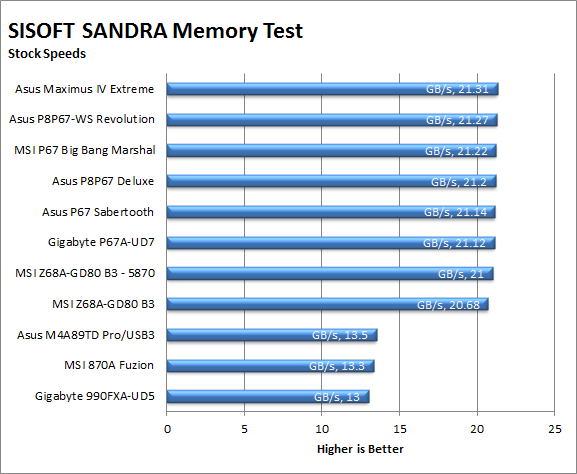
The memory performance on the MIVE at stock was very solid. Although it did not run away from the pack we do see it out in front. This small difference in memory performance can help it run a little faster in tasks like Encoding audio and video, encrypting and decrypting as well as rendering tasks like we see in our Lightwave and Cinebench tests.
| AIDA64 Stock Memory Performance | AIDA64 Overclocked Memory Performance |
 |
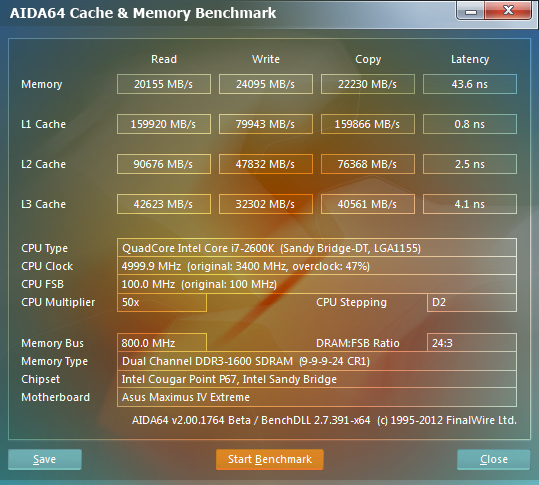 |
AIDA64 shows us the details behind the scores we see from SANDRA. It looks like the trace tuning we talked about on the board is helping the IMC do its job much more efficiently than we have seen on other boards.
The overclocked performance even at 5GHz was not that significant, this is because the memory speed did not change between the states (stock and overclocked) AIDA64 does show an improvement cross the board, but it is not enough to bring it back to the top of the pack. We did not have time to try all of the memory tweaks available to get the memory speeds up and maintain the 5GHz OC.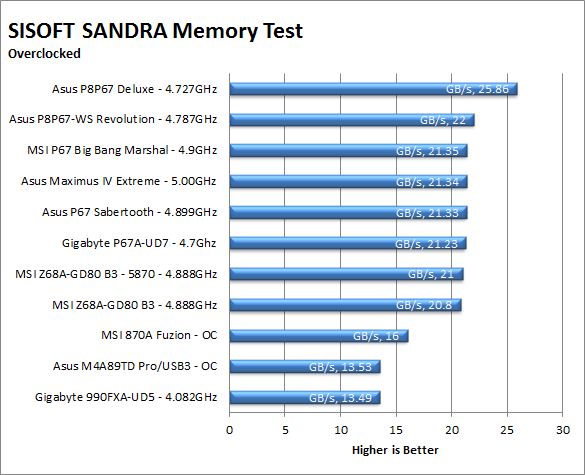
Drive performance;
Drive performance is also one of the major subsystems that goes to make up the performance of a motherboard. For our testing we use Sandra and AIDA64 again. We only test with single drives for each type of controller present on the motherboard (unless it is a professional product where we will use RIAD 5 and/or 10). We have also begun using a Seagate PS-110 USB 3 external HDD for our USB 3.0 performance. As a side note, we include the overclocked numbers here to make sure (again) that you are not going to see a major drop in performance due to minor instabilities at high clock speeds.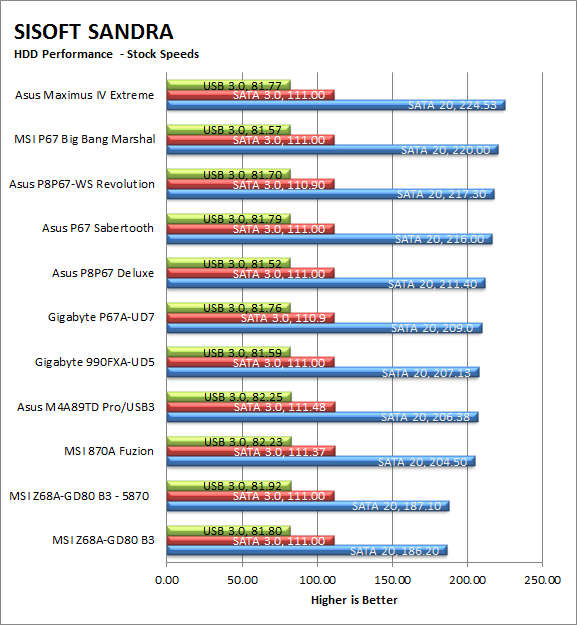
At stock speeds the MIVE manages to pull out in from of the competition by about 4MB/s this like the memory performance difference is not a lot, but it can mean much faster performance in the same type of applications (Encoding, Cryptography, Renderings) and when the two are combined it can only benefit these applications. 
When we overclocked the system the HDD performance dropped a bit which was a little surprising. We would not have expected this and with the minimal gain in memory performance this could have an impact on our performance numbers later on.
| AIDA64 Sock HDD Performance | AIDA64 Overclocked HDD Performance |
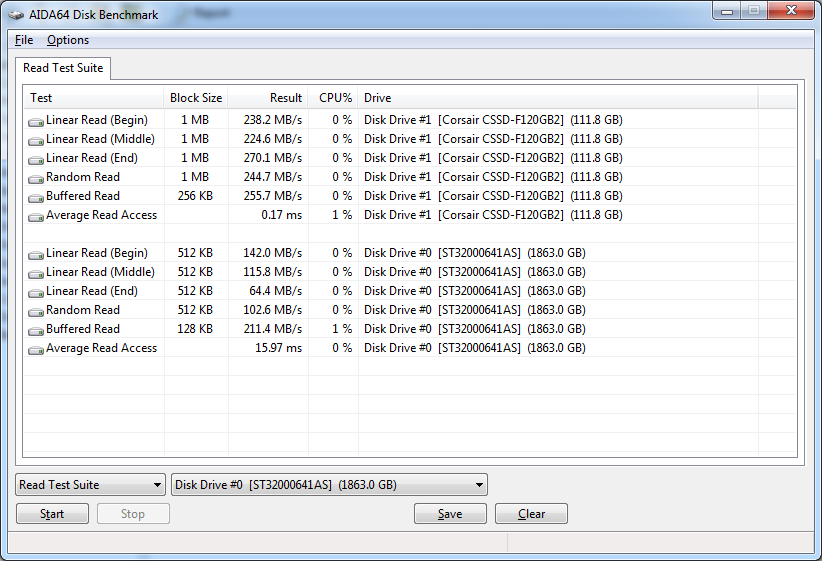 |
 |
| ADIA64 Stock USB 3.0 Performance | AIDA64 Overclocked USB 3.0 Performance |
 |
 |
AIDA64 rounds out the information we have about HDD and even USB 3.0 performance. We were still able to get USB 3.0 working when we have the MIVE overclocked (which was nice).
Power -
Power efficiency is another of those misnomers that we get caught up in. We hear about idle states and power gates. But what does that mean to you and I? On the surface having power management that reduces idle power sounds great and can be a benefit to someone that leaves their system on for long periods of time (and inactive) but how a system handles power under load and the delta between the two states is often more important than the idle power usage numbers. We use only P3 Kill A Watt instruments for measuring power. 
The Asus Maximus IV Extreme was not the most power efficient board we have tested. This was an odd occurrence as we have seen the Asus EPU software and hardware offer some nice power savings when left on Auto. However, this time we did not see that. Granted the performance was not terrible, but it was more than what we would have expected. When the board was overclocked,… well you have to expect it to use up quite a bit more power.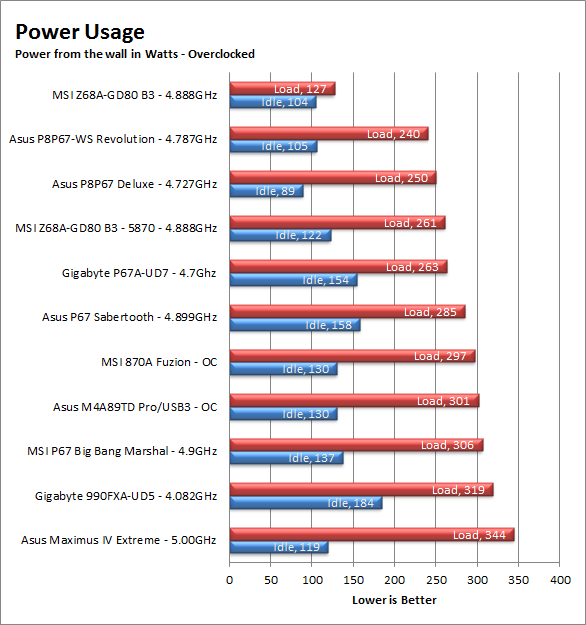
Cooling (Board Level)
Board level cooling is an important factor in product performance and longevity. Components like the chipset, VRM modules and even capacitors need to be kept relatively cool to prevent failure. As these parts are made of silicon, they have a thermal breakdown threshold; or melting point. At that temperature the actual transistors built into chip will begin to deform and break down. Granted, the threshold is often very high, but you still need to make sure that components stay away from this level of heat for longer product life. 
Heat on the Maximus IV Extreme could be a problem. As you can see here if there is not good air flow then you could run into problems pretty quickly. Our open test platforms do not have good air flow across them; which is why you see the temps we have here. As long as you make sure the case you chose has adequate airflow over the CPU and power regulators you will be ok. 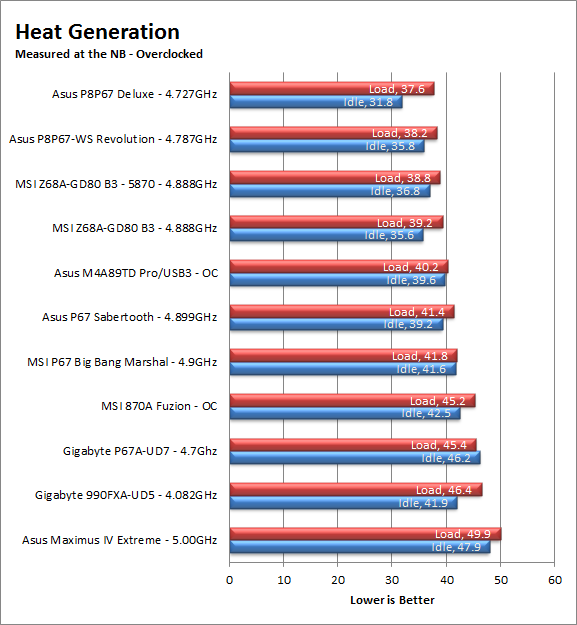
Audio -
Audio is highly subjective. What we find pleasing may sound “off” to you. That is always going to the problem with testing audio; results will vary too widely depending on the tastes of the listener. However, there are ways of measuring the audio output with an objective ear. There is also the issue of audio causing performance issues in gaming and video playback. The reason this is a potential source of concern is that all onboard audio CODECs (Compression/Decompression) are CPU controlled. This means that while the audio chip controls the audio levels and effects of the audio the actual work is done on the CPU. Usually this will not be a problem with today’s powerful CPUs. Even the lower and consumer level products can handle high-end audio these days. But again there is the chance that a bad design or software will hinder your system and performance. On the other side the limits of board space, cost, etc will also prevent the level of audio quality you can get from an add-in board. We test all audio parts with three media types, Movie (DVD), MP3 Music, and Gaming. These are pushed to our Tec On model 55 Tube Amp to see if we can detect any signal issues in the reproduction.
Asus has always had good audio on their boards even when all they drop in is a Realtek audio CODEC. On the higher end ROG boards they do add a little bit extra into their audio software. This is one of the advantages of having a CODEC like ones from Realtek or SoundMax; as much of the audio processing is done on the CPU you can really tweak the software to get the sound you want. The down side is that this can impact performance. Still we found that the audio on the Maximus IV Extreme, while good enough for most activities is not going to satisfy those that demand top-notch audio for gaming and media playback.
Networking -
This one is something that is a requirement anymore. If you have a computer, the chances are good (like 99%) that you are also connected to high-speed internet. With this you need a good and solid LAN chip to make sure that your data flows properly out and back.
Asus made the decision a last year to put Intel LAN controllers on all of their top-end and mainstream boards. The Extreme editions of the ROG Lineup get two of these just to make sure you have the networking performance you want and need. Right now for the money Intel has the best LAN controllers when it comes to performance and reliability; this decision only adds value to Asus’ products. Our experience with the Intel LAN controllers on the Maximus as smooth, we did not see any lag or problems moving large files or even streaming media like Netflix. Then again you would probably not see this with RealTek or Broadcom, but both RealTek and Broadcom have had issues with drivers that make their performance and reliability iffy.
Section II - Performance Tests, Synthetic
In this section of testing we cover the synthetics. These are tests that run a scripted sequence of internal APIs or that use another installed application to perform a series of scripted events. They are great in that they can provide reproducible results across various platforms. On the down side, synthetic tests can be fooled with driver tweaks and optimizations. In some cases it is necessary to rename the .exe file to something generic to discover if this is the case. In any event when this is needed (when a test shows a drastic difference in performance over the renamed exe) we will note this and show both results for comparison.
PCMark7 -
PCMark7 is the latest general performance test from FutureMark. As each generation of this benchmark has evolved and developed we have watched them add more and more realistic tests to this suite. With this generation we find more media tests, (audio and video transcoding) moving of large files, multiple web page rendering, and much more (the even added DX10 gaming). We use the Overall Performance and Common Usage suites in our testing.
This is sort of funny when you look at the chart here. The Maximus IV Extreme and the P67 Sabertooth ended up in a tie for first place (as far as PCMarks go). The individual scores break down a little, but still it shows that the MIVE can keep up for general computing. Of course with the 5GHz OC we were not surprised to see it sneak past the Sabertooth. 
3DMark 11 -
3DMark 11 is the other Futuremark test that we run on our motherboards. This test simulates the typical tasks that a GPU (and system) would have to perform to provide you with a good gaming experience. It is based on the DX9, DX10 and DX11 engines but can only be installed on Windows Vista or later. The suite of tests covers DX9, DX10, and of course DX11 rendering; it also covers AI computations and physics. That’s right I said Physics the latest version of 3DMark uses a Havok physics engine. This removes the advantage that nVidia had with 3DMark Vantage. 
For 3DMark performance the Maximus sneaks out in front for our stock performance run. It is not much of a lead here and while it does allow us to call a “winner” all it really does is show that the Maximus IV Extreme can handle the tasks that come with gaming. In our overclocked testing the MIVE drops a little, we are sure this is more about memory than anything else. The Z68A-GD80 had some solid memory numbers that are coming into play here. If we can get the memory speeds stable at over 1600 MHz (at 5GHZ CPU clock) we are confident these numbers would be different for the OC tests… but then again that is overclocking results will vary.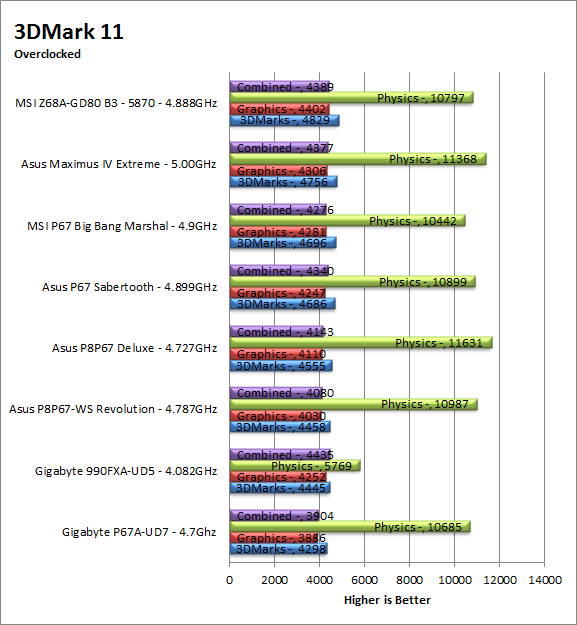
HyperPi 0.99b -
HyperPi is a front end application that allows you to easily run multiple instances of the SuperPi application. SuperPi, for those that are not familiar with it, is an application that measures the time it takes to calculate the number Pi out to as many as 32 million places. This calculation is then checked and run multiple times (up to 24 for a 32M run). This test stresses the CPU, Memory and HDD as data is handed off between the three. If there is a weak link, HyperPi will show it. For our testing we run the 32M test on as many cores (and threads) as the CPU has available. The slowest CPU time is then recorded. 
At stock speeds the Maximus IVE does very well in our HyperPi testing. This hits the memory and HDD subsystems pretty hard and is a good indication of how well they will hold up under stress. We see this same thing reflected in the overclocked scores. Despite having the CPU at 5GHz the Maximus loses ground pretty quickly. 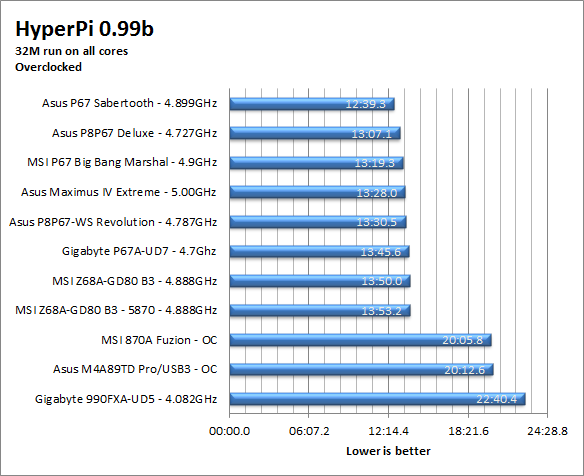
Cinebench R11.5 -
Cinebench R11.5 is the 11th release of Maxon’s rendering test. This test is based off of the Cinema 4D engine, which is one of the industry standard tools for digital animation. It is a powerful product with many different modules that can be “plugged” into it to increase its effectiveness. With Cinebench you get to see how your computer would do using this application. There are two tests; one tests the CPU’s ability to render an image across multiple cores or threads. The other tests your systems ability to handle OpenGL based rendering. 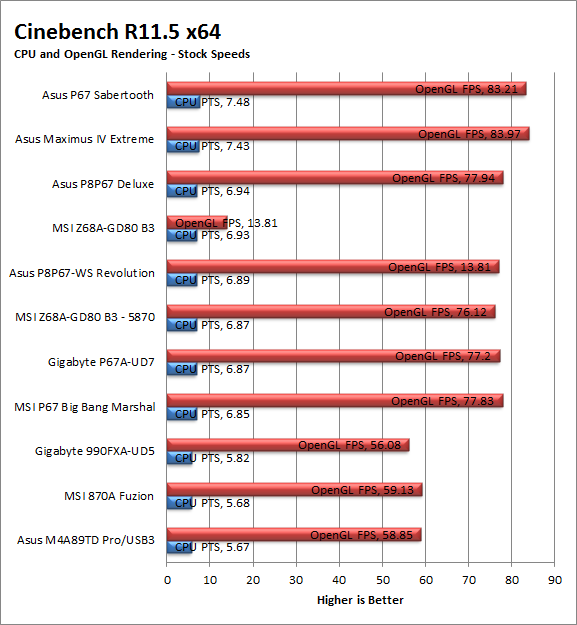
At stock speeds the MIVE does well even though it is a little behind the Sabertooth in terms of points. The lead is only .05, but that can be a big deal when rendering large projects (as you will see in our Laightwave testing). Once we push the CPU to 5GHz on the Maximus things are a little different as you might expect.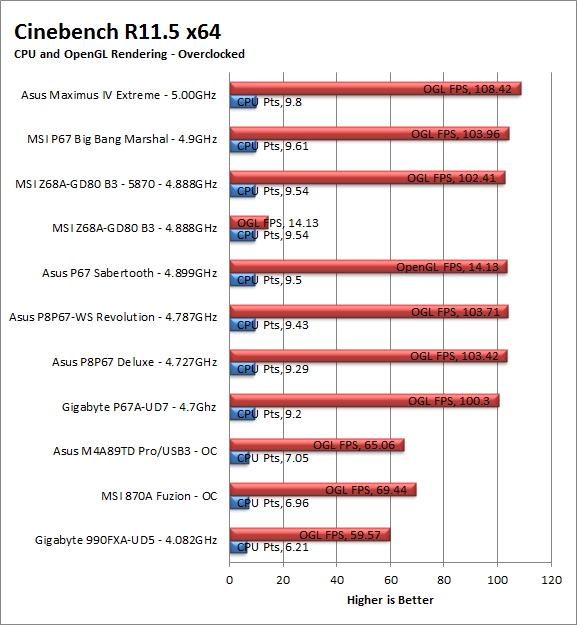
Section III - Performance Tests, Real-World
Here we have two tests that are designed to put the performance of the motherboard and its subsystems to the test. Both require good CPU, Memory, HDD and even to a lesser extent audio and network performance. The two tests we chose were Lightwave 3D 9.6 and AutoGK 2.55. We will be adding at least one more real-world test to this battery in the near future, but for now these two cover quite a bit.
Lightwave 3D 9.6 x64 -
Lightwave is another industry standard application for 3D animation and rendering. It has a large tool base and the rendering engine is highly threaded (when using the right render model). This application is also capable of expanding to 4k resolutions as well as ray tracing for rending the light sources. For our testing we use frame 470 of the Pinball scene found in the LW 9 Content folder. This uses the newer perspective camera that is better suited to a multi-CPU/Core environment. This camera style also uses ray tracing and a much improved anti-aliasing method. Settings are shown below in the attached screen shot. Of course these are single frame renders and they are not a complete picture; for that you have to take into account the number of frames an average project would have. In a typical 30 second commercial you will have around 840 to 960 frames (at 28 – 32 FPS) this means that you have to multiply the time of a single frame by that number just to get a vague idea of how long that 30 seconds would take. This is because each frame will have a different render time based on complexity.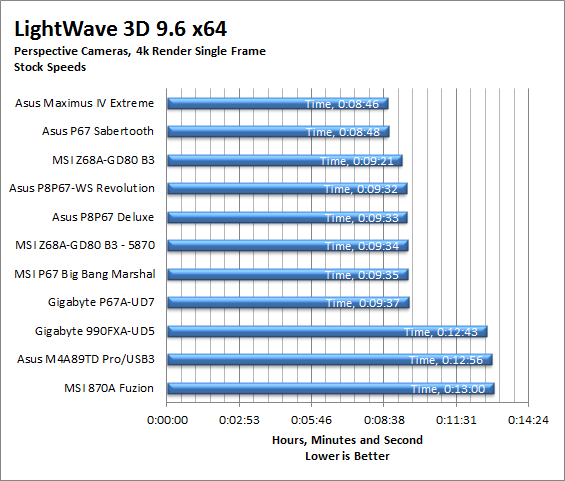
It looks like the combination of good memory and HDD performance is paying off as you can see in our Lightwave testing. The two second difference in our single 4k Frame test might not seem like much until you put it into the 30 second project estimation and that point it is becomes a 30 minute difference.
Our overclocked run on widens the gap between the MIVE and other motherboards in this group. 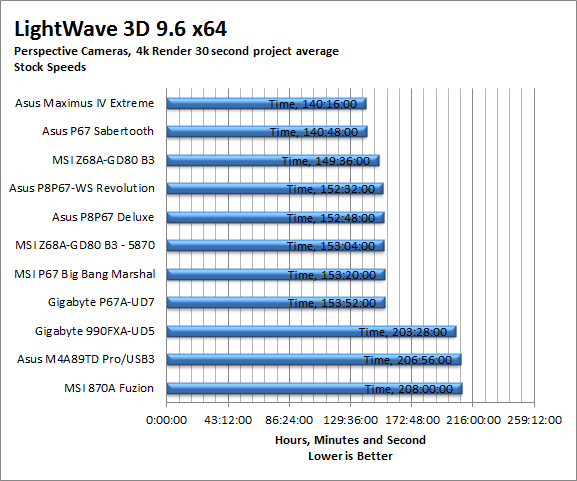

CyberLink Media Espresso 6.5 -
After having various issues with AutoGK and Intel CPUs with more than four cores we have changed our Media Encoding test to use Media Espresso from CyberLink. Although this new utility does not have the same ability to transfer directly from DVD it is still a good test to transfer different media types into a usable format for your iPad, iPod, or other media player. Our test involves using multiple (Six) 20 minute media files and transcoding them for an iPad. This gives us a very good indication of how well a motherboard can handle this type of work load.
The MIVE is the first board that we are using the new Media encoder on but after multiple runs of this test we are seeing times that are just a little below what the average is for this work load. It will be interesting to see how this test works out on Intel’s new Sandy Bridge E CPUs when there is more memory bandwidth available.
Section IV Performance – Gaming
Gaming as a test of motherboard performance is sort of a joke these days. The big player in the gaming arena is the GPU. Everyone but a few hardcore PR teams know this. However, it is important to run at least a few (one from each current DX version) to see if there are any issues with the combination of components on a motherboard. These are items like Audio lag, memory lag and of course problems with the PCIe lanes and signal traces. If there are issues in design, drivers or BIOS then you can have odd gaming performance. So without much more preamble let’s dive into the three games we currently use; Call of Duty Modern Warfare 2 for DX9 FarCry 2 for DX10 and Battlefield Bad Company 2 for DX11.
Call of Duty Modern Warfare 2 DX9 -
This is an excellent but short game that put you right into the action from the beginning and does not let up the pressure until the very end. The graphics are a little better; most notably the night and thermal imaging have been improved. The AI is still the typical COD “bar fight” style AI, with maybe a tad more finesse. All in all it is not a bad game to play and a decent one to use for testing. Our testing run starts at the bridge and ends after you clear the school in the first level of the game. Settings are shown below as are the performance numbers.
 |
 |
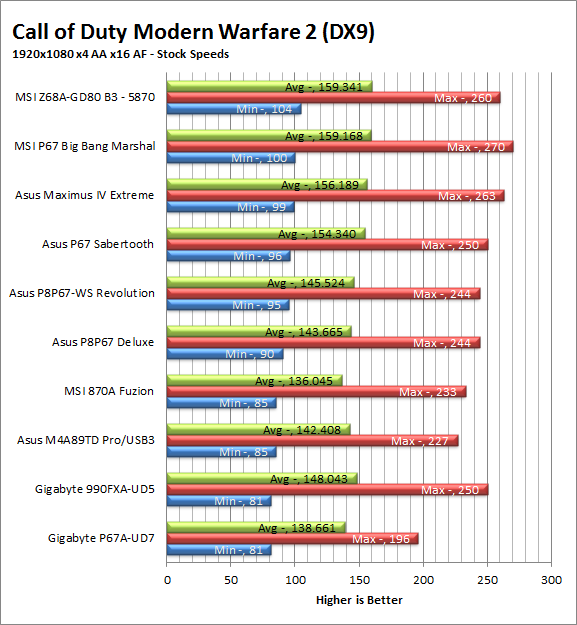
Now some of you might be wondering why we are continuing to use an older game like Modern Warfare 2 in our testing. Well it is pretty simple; Modern Warfare 2 is still played regularly by a large group of people. Our DX9 game choice was made to include a popular game and MW2 was a great choice. 
As you can see though most of the test systems we have thrown it at are capable of running MW2 at over 90 FPS minimum. This means it is time for a change. We will be moving our DX9 game choice to Modern Warfare 3 shortly. As for how the MIVE does, well it manages to pull off 99FPS minimum which puts it in third place according to the rankings. Unfortunately,… at these speeds you would never notice a 5FPS difference even if they were side by side.
FarCry2 DX10 -
Although not one of my favorite games this tedious game does have some good graphics. The large sandbox style of the game lends to mission based play. The only problem is that the AI is rather low grade. Still the more CPU power the more the bad guys try to do. Over all the game was a little bit of a disappointment to play, but still not a bad DX10 representation. Our testing run starts right after you get your first mission to clean out the safe-house and ends after the hostage rescue. Settings and performance numbers are shown below.
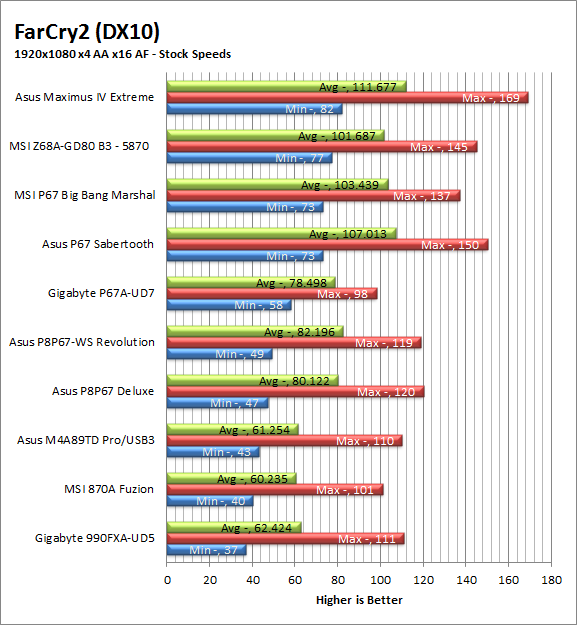
Our DX10 gaming choice is also getting a little dated although it still can be hard on a system (and look at how long people used Crysis as a test) Here we find the MIVE at the top of the heap. Again the 5FPS difference is not something that you would be able to detect. You might pick it up if you were using V-Sync or if you wanted to run nVidia 3D Vision, but for regular gaming it would not make a difference in the way it looked on the screen. During our overclocking tests the MIVE dropped a few FPS and ended up back in third place.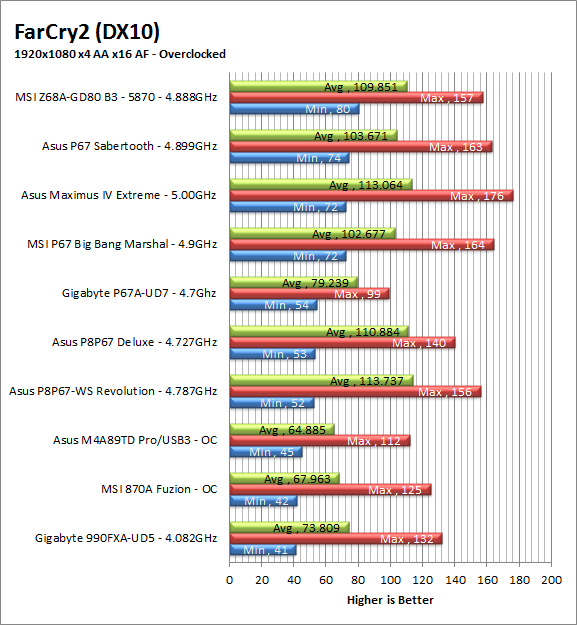
Battlefield Bad Company2 DX11 –
I have liked many of the Battlefield games. They usually tend to be fast paced and fun. With Battlefield Bad Company 2 you do get some of that, but there is something about the graphics and the movement that just does not sit right. The AI is a less sophisticated form of the bar fight AI, but it gets the job done. Still, the game is good for testing as it can put a strain on the components of the board. Out testing run is the entire first level, from beginning to end. Settings are shown below along with the raw numbers.
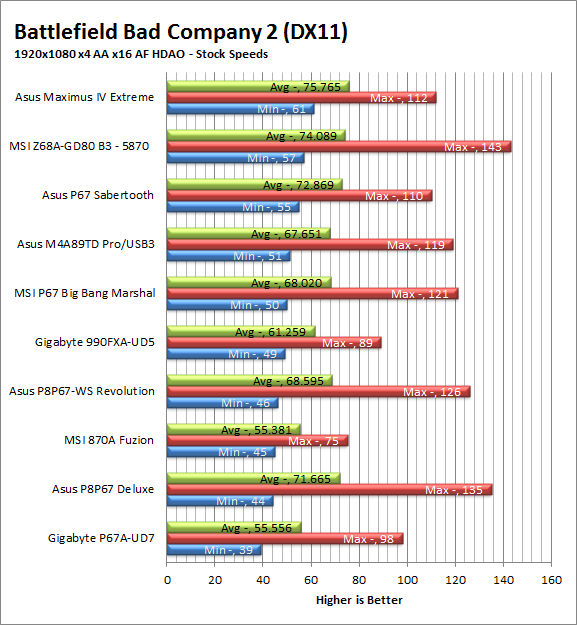
Even under Bad Company 2 the MIVE gives solid gaming performance. With just over 60FPS minimum you are going to have very smooth game play here. Once again when we OC the CPU we lose a couple of FPS, but not so much that it would affect game play.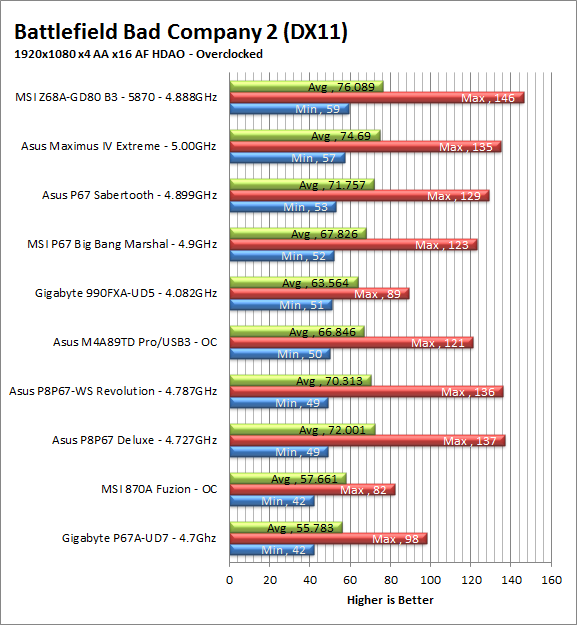
Gaming wrap-up -
High-performance gaming is (well it has been) much more about the GPU in terms of frame rate. However, there is more to gaming than just frame rate. We have had test systems that can give solid frame rates, but when you combine audio, level load times, and networking performance you ended up having a much lower quality gaming experience. This was not the case on the MIVE. We had quick level load times, good audio (although not great), and of course the network game play was speedy thanks to the dual Intel LAN controllers. You might not get the highest frame rates out, but the overall experience with the MIVE is going to be solid in terms of PC gaming.
Value -
Value is another very subjective topic. What is expensive to some might be a deal to others. You can look at this topic in multiple ways. One is raw price and the other is what you get for the money. Each is accurate and both are correct ways to look at price/value. We tend to look at features, performance and real-property when we discuss value. However, we also take into account the raw cash cost of the item. Asus’ Maximus IV Extreme will cost you $289.99 from most online stores. Now $290 might seem like a lot of money to shell out for a motherboard, but this pricing is much better than it looks on the surface. When you compare this to other products in its class and then look at the features each offer you will find that the $290 price tag is quite a bit more acceptable than it looks at first glance.
Conclusion -
Some of you might be wondering why we bothered to review the Maximus IV Extreme when the Z68 is out and the Z77 is coming out in a couple of months. Well it is really quite simple; we covered it because it is an outstanding product. The web ended up overlooking products like the Maximus IV Extreme within a couple of weeks after launch. The excitement of a new product dies down and it can be quickly lost in the maze of newer boards. However, a real test of a product is to see where it is at a few months after its launch. This allows for plenty of time to tweak the BIOS and make important changes to the drivers and utilities which only provide for a better product. Asus has put this time to very good use. Although the Maximus had a solid BIOS when it launched the latest revision does improve several key factors. Most notably memory performance and compatibility has been improved over the last couple of BIOS releases. This means that the product you read about a last year is not the same as the one that we covered here. The Maximus IV Extreme is a great product and one that anyone looking to upgrade should include on their list. In all honesty it has been one of the best P67 boards that we have tested since their launch back in 2010.
Discuss this in our Forum

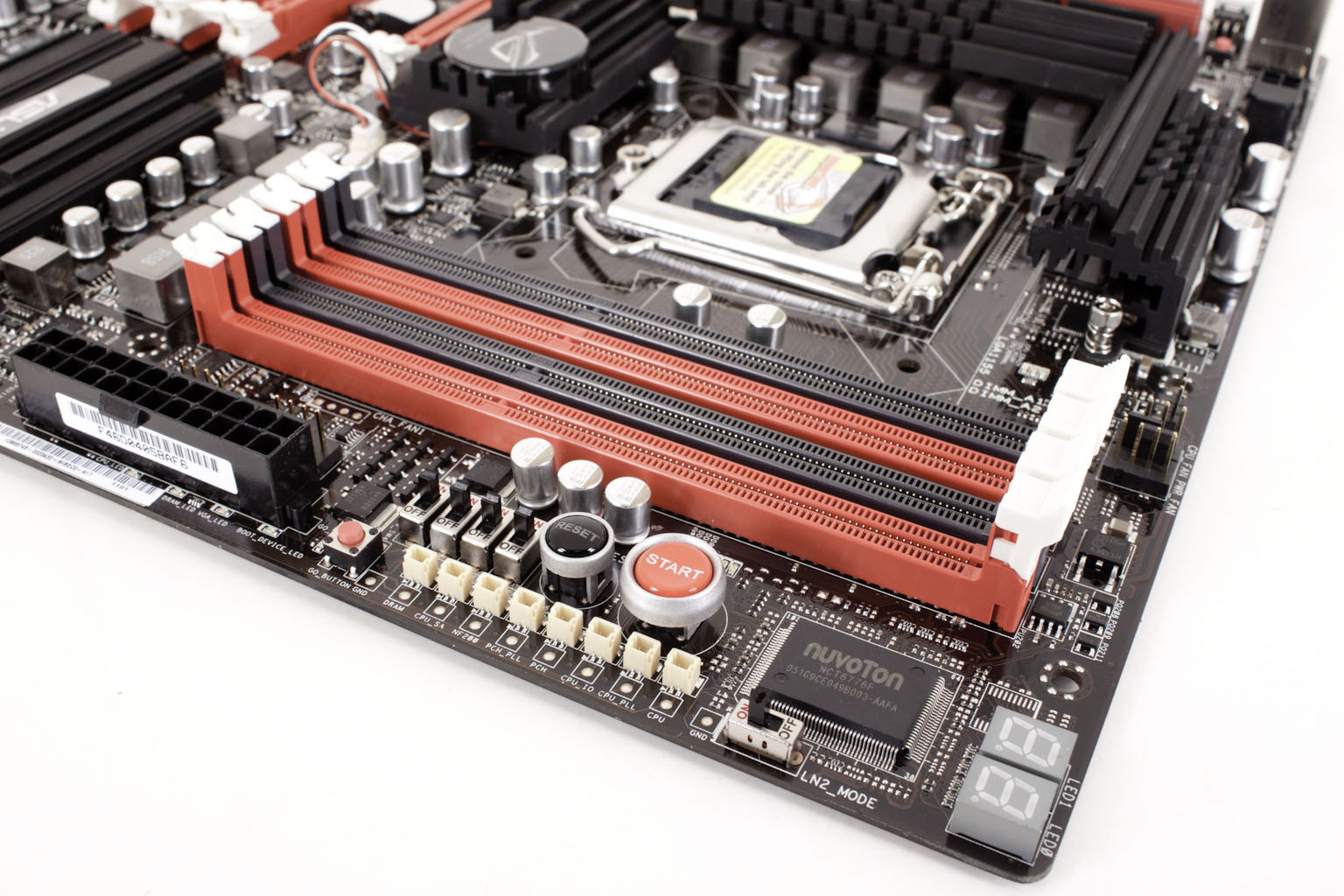 Asus’ Maximus series has always been a great line for the user than demands top notch performance. We have tested them going all the way back to the original Maximus and each one has brought new performance features to the table. As you have seen in our
Asus’ Maximus series has always been a great line for the user than demands top notch performance. We have tested them going all the way back to the original Maximus and each one has brought new performance features to the table. As you have seen in our 

